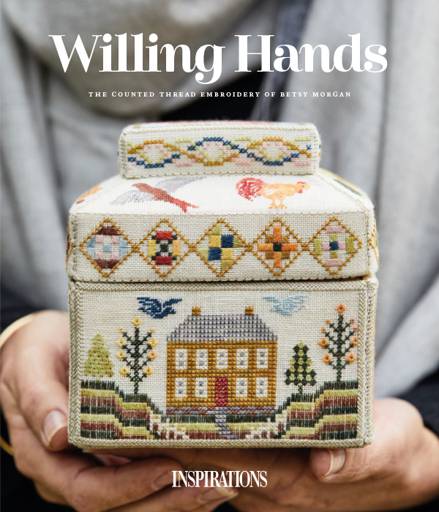This One’s for Betty by Betsy Morgan
15TH NOVEMBER 2019 - ASU #212
biscornu (adjective, French) – bizarre, misshapen, skewed

This French adjective has come to be used as the name for a distinctively shaped pincushion that is both enchanting and a little mystifying the first time you see it.
A biscornu is made by sewing two squares together in such a way that one is positioned to be on point to the centre of the other.
Each edge of each square is stitched around a corner on the other square, distorting the edges and creating the curious and unique shape of a biscornu.
Betsy Morgan has taken the concept of a biscornu beyond a pincushion, using the shape to create an exceptional etui named in honour of her dear friend and mentor, Betty Flemming.

The project ‘This One’s for Betty’ from the book ‘Willing Hands’ features stitched designs inspired by Elizabethan spot samplers and reflects the range of stitching enjoyed by 16th century embroiderers for the decoration of household items and clothing.
The etui includes motifs such as fruits and flowers, birds, scrolling stems of flowers and berries, colourful geometric designs and a blackwork border sample along with a whitework design.

The black thread used throughout to outline and stitch panels together, and for closures, echoes the blackwork motif. It reminds us of the way blackwork was used to embellish clothing during the Tudor and Elizabethan periods.

The selection of delightful ‘smalls’ that go with this etui continue the Elizabethan theme. Just as Elizabethan owners of embroidered caskets would sometimes keep little toy models of household objects in their casket, the stitching accessories are charming miniatures to be kept in the etui.

The thimble bag is based on lavishly embroidered Elizabethan sweete bags, with a characteristic botanical embroidery design and drop crystal beads standing in for tassels along the lower edge.

The button pocket replicates the style of pockets worn beneath the outer layers of a woman’s dress, tied to the waist. An example can be seen on a 17th century doll HERE.

The needle book, with gorgeous floral and acorn motifs, has a wide border stitched in green, placing the motifs within a formal garden.

The scissor fob, which is the same shape and even smaller in size, is reminiscent of a gable wall of a house. The wide border, stitched in a dusky pink, suggests the squared timbers used for support and decoration on half-timbered buildings.

Continuing the miniature theme, the shape of the etui itself is replicated in the endearingly small pincushion and waxer box. The pincushion features blackwork and geometric patterns, and a large pomegranate, an enduring motif in embroidery.

The waxer box biscornu is a container made in the same manner as the etui, this time to hold a piece of beeswax to use for strengthening threads. The motifs include a planter box with the plant worked in Bargello embroidery, or Florentine work, and the geometric design on the base can be seen on an Elizabethan sampler worked by Martha Edlin, whose embroidered casket inspired the Elizabethan Casket Etui.

This captivating etui has an absorbing variety of motifs to enjoy, rewarding the maker in both the stitching and the finished objects. Can’t you just picture yourself opening your biscornu case, laying out the accessories and deciding which is your current favourite? It might well be all of them!
Make Your Own | This One’s for Betty Etui

Step 1 – Purchase Project Instructions
This One’s for Betty by Betsy Morgan from Willing Hands is a biscornu-shaped etui adorned with beautiful floral, fruit and geometric designs.

Printed Book
Willing Hands
Shop NowStep 2 – Purchase Ready-To-Stitch Kit*
The Inspirations Ready-To-Stitch kit for This One’s for Betty includes everything you need to re-create this beautiful etui and accessories: Fabrics (unprinted), interfacings, interlining, felt, beads, embroidery threads, ribbon and needles.
Please Note: To cater for flexibility of purchase, instructions are not included with our kits. For step-by-step details on how to create these projects, please refer to the book Willing Hands.
